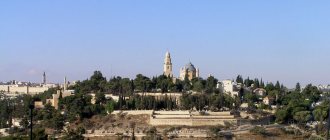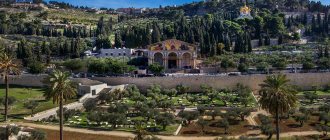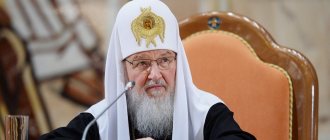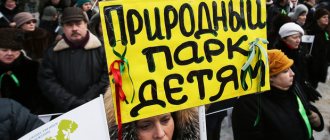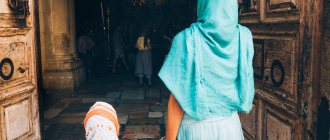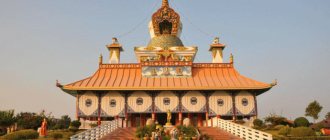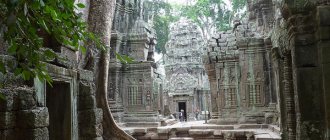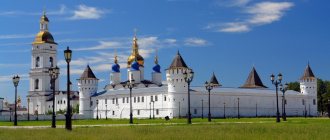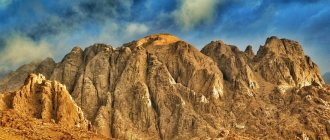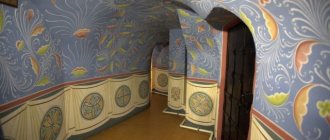After the Last Supper, the night before his arrest, Jesus communicated with God the Father in the Garden of Gethsemane. He came there with His disciples, wanted them to support Him, and the prayer was a congregational one. But all 12 apostles fell asleep under the olive trees and slept until the morning. Christ woke them up before the arrival of Judas Iscariot and his guards.
Currently, the Garden of Gethsemane occupies a small area. It still has olive trees, but they were planted 11-12 centuries after Christ. There are no witnesses left to the last prayer of the free Jesus in a human body.
Story
The Gethsemane prayer is described in many church books, and primarily in the Gospel. During the entire period of Jesus' preaching, 12 of His disciples followed him. In fact, there were much more open and secret supporters of Christ. The facts testify to this. After all, someone gave Him his donkey so that the Savior could make a triumphal entry into Jerusalem. The owner of the room on the top floor remains unknown, but he knew to whom he was providing the premises and why.
Gethsemane was private territory at that time. The gardens were guarded and no one was allowed to just walk through them. The confidence with which Christ entered the Garden of Gethsemane suggests that the owner of this section of the valley was a secret supporter of Christianity and deliberately provided his Maslenitsa grove to the Savior and the apostles.
The Roman rulers felt that Jesus' popularity was growing. The idolaters were afraid of this and tried with all their might to destroy Christ as quickly as possible, to prove that the Messiah does not exist.
On Thursday before Easter, Christ and his disciples went to the Garden of Gethsemane in Jerusalem. Entering it, he invited his followers to sit and wait for Him while he prayed. He invited only three with him: John, James and Peter. It was they who witnessed his Transfiguration the day before.
Having walked deep into the Maslenitsa grove, Christ in the Garden of Gethsemane began to yearn and grieve. "My soul is dying." He then addressed a trio of especially trusted disciples: “Stay here and watch with Me.” Having moved within a stone's throw, Jesus began to pray for the cup. The words of this text, the address of the Son of God to the God-Father, are known to every Christian. “My Father! Pass this cup past me.” Then, as if remembering his appointment as a Savior and the atonement of human sins through suffering, he added: “However, not as I want, but as You want.”
Having risen and approached the three faithful disciples, Jesus saw that they were sleeping. He turned indignantly to Peter, asking him if they could not all stay awake for only one hour. Then he told them to stand and pray with Him.
But the apostles fell asleep again, and Christ read His prayers alone. Only the Angel of God flew in and supported Him.
In the morning, Jesus woke up His disciples and told them that it was time to go, His hour had come, the one who betrayed Him was approaching.
Judas Iscariot approached Jesus and kissed Him. So he showed the soldiers and servants of the high priests who Christ was, whom they had come to arrest. Since then, the expression “kiss of Judas” has appeared among the people, which means betrayal and false flattery.
Defending the Savior from the attackers, Peter pulled out a dagger and cut off the ear of one of the servants. Then Jesus said there was no point in resisting. He can ask the Father for a huge army in His defense, but he will not do it. Everything that happens is God's will and should be obeyed. After this, He lifted up the ear, put it in place, and made it grow, healing the servant of the high priest.
Jesus then addressed those who had come to arrest Him. He recalled that more than once they sat next to each other in the temple and listened to Christ’s sermons. And now they attacked Him with swords and daggers, like a criminal. After these words, the apostles ran out of the garden. The soldiers tied Jesus up and took Him to their ruler in Jerusalem.
INTERESTING: Cathedral of Christ the Savior in Moscow.
Biblical story
Behind the high walls of noisy Jerusalem, on the western slope of Mount Olivet, stretched the picturesque Gethsemane Valley, in which ancient olive trees grew. Christ loved to come to this quiet grove, accompanied by his disciples, to indulge in prayer in solitude and peace. He came here after the Last Supper. Jesus, the Son of God, incarnate in a human body, knowing about the upcoming suffering and torment, asked his Father to deliver him from the sorrowful cup.
Icon of Jesus Christ “Prayer for the Cup”
This prayer reflects the true essence of the incarnation of Jesus, as a person who is characterized by sorrow, fear and despair. But at the same time, Christ, showing an example of true virtue, resigns himself to his fate and trusts in the Will of the Lord.
Having finished the prayer, Jesus returns to the disciples and, finding them sleeping, reproaches them for their weakness. And at this time, the guards, accompanied by the traitor Judas, are already approaching the garden to arrest the Savior. From this moment the passion of Christ begins, ending with death on the cross.
Read about Christ:
- The Suffering of Jesus Christ
- Death of Jesus Christ
- Resurrection of Jesus Christ
How to get there
Tourists who want to visit the Garden of Gethsemane and other places dear to every Christian and located nearby can take a ticket for a special tour. In this case, all they have to do is get to Moscow. Then the travel company will take them to Israel and take them to all the holy places.
Independent travelers arriving in Tel Aviv can choose several ways of travel: taxi, intercity bus, rented car with or without a driver. Excursions can be booked on site. Each hotel serves its clients with a cultural and religious program. Only the room must be booked in advance. There are many people who want to visit the Mount of Transfiguration, the Garden of Gethsemane and other places.
Yandex.MapsYandex.Maps
To get to the garden, you need to go to the Kidron Valley, to the foot of the Mount of Olives, to the Church of All Nations. Palestinian buses number 43 and 44 run from the Damascus Gate. They carry their passengers along the same route. You should choose buses No. 1, 2, 38, 99. You should get off at the Lion Gate stop. There is less than 500 m to go from there.
Gehena Fire
Speaking about the cemetery, I also remembered the prototype of the holy cemetery - Gehena of Fire. True, this terrible place, a fiend of hell, is located south of Jerusalem in the valley of Hinnom.
Gehenna is a valley southwest of Jerusalem and a symbol of Judgment Day in Judaism and Christianity, and in Islam it is equivalent to the word “Hell”.
Gehenna of Fire
The Valley of Hinnom (Greek “gehenna”) is one of two valleys (the second is the Kidron Valley) near the city of Jerusalem. It was the site of various kinds of pagan rituals associated with fire.
Gehenna of Fire, Jerusalem
According to the guide, this place is described many times in the Old and New Testaments, the valley of Hinnom of God's punishment, curses and desolation, a place for angry evangelical and Koranic sermons, promising eternal fiery torment for apostates and sinners. Here, pagan rituals included holding children through fire (in early times, human sacrifices to the scorching sun), executions were always carried out - people were burned alive, corpses were dumped with garbage. There was no free space in the Valley of Fire due to constant executions. The stench of burnt human flesh always lingered here and rose over the city.
“And do not be afraid of those who kill the body, but are not able to kill the soul; but fear Him more who can destroy both soul and body in fiery hell.” (Matt. 10:28)
To be honest, I never thought that this place existed in nature on a physical level; “fiery Gehenna” was always presented as a metaphor describing hell and horror, but no! And today this terrible place looks quite pretty.
Kidron Valley
The Kidron Valley is often mentioned in the Bible; according to Christian eschatology from the Old Testament, it is believed that the Last Judgment will take place in the valley. It starts east of Jerusalem and divides the Temple and Mount of Olives.
Features of the Garden of Gethsemane
In the seventies of the first century, the Romans completely destroyed Jerusalem and cut down all the Maslenitsa trees. Legend has it that olives are amazingly resilient and have regenerated themselves from the roots left in the ground. Scientists conducted a DNA analysis and came to the conclusion that on the Mount of Olives there are trees, the upper part of which is much younger than the underground part.
In the second half of the 19th century, the garden came under the jurisdiction of the Franciscan Order, which belongs to the Catholic Church. The monks erected a stone fence around the perimeter, protecting the shrine from the accidental entry of animals and unwanted visitors.
Millennial olives
This area is called Gethsemane, which means “oil press” in Hebrew. And this is not without reason. The garden is famous for its olive trees. Italian researchers conducted a test and found out that the age of eight of them exceeds a thousand years. And they come from one “ancestor”, who was probably a silent witness to biblical events. Surprisingly, the trees still bear fruit.
Most likely, the garden was much larger than it is now. In 70, the Romans seized the land and cut down some of the trees. But even the small part that has been preserved attracts a sufficient number of tourists. This is an ideal place for meditation and other spiritual practices.
Churches of Gethsemane
After the Resurrection of Jesus Christ and the spread of Christianity, temples belonging to different denominations began to be built in the Kidron Valley, in the olive gardens.
Church of All Nations
The first to appear was a temple belonging to the Franciscans, called the Church of All Nations. Inside it, next to the altars, lies a large stone. According to legend, it was on it that Jesus prayed on his last night, before he was arrested and taken to torture.
Church of the Assumption of the Blessed Virgin Mary
In the Church of the Assumption of the Blessed Virgin Mary, the remains of Anna and Joachim, the parents of the Virgin Mary, rest. The Mother of God herself is buried here. Confirmation of the authenticity of her burial was received after opening the grave. From it they took out the belt and burial shroud of the Mother of God.
The Church of the Assumption is administered by the Orthodox Church of Jerusalem and the Armenian Apostolic Church.
Church of St. Mary Magdalene
Gethsemane Convent is located in the Russian Orthodox Church of Mary Magdalene. The buildings of the temple and monastery are classic examples of Russian architecture. The church was built in memory of the empress's mother. Its 7 domes are shaped like an onion
Architectural Splendor
Church of All Nations
Barluzzi was a magnificent architect who, with the help of architecture, was able to create an atmosphere, convey sensations, and comply with all religious canons. After all, the task before him was not only to build a beautiful and majestic building, but also to emphasize the situation that is celebrated in it.
On the night of his execution, Jesus Christ was afraid and prayed for forgiveness. And all this was impossible to show using the techniques of those times. However, Barluzzi managed to convey the pain and suffering of a great man, creating a truly masterpiece building. Entering it, you will plunge into twilight, at the end of which the altar is illuminated with lamps. The architect first achieved such an intimate atmosphere with aquamarine stained glass windows, which were able to retain most of the sunlight.
The entrance to the temple is located opposite the Golden Gate, into which the Son of God entered at the beginning of his journey. The facade that you can see today is inlaid with an elaborate mosaic depicting the prayer of Christ. Near the entrance, you will also see columns that support the figures of the evangelists.
Interesting! The 12 domes of the temple symbolize not only the patron countries, but also the twelve apostles.
Gethsemane Grotto
In Gethsemane, a grotto has been preserved where Jesus Christ prayed at night. On the floor there were traces of bloody sweat that dripped from the Savior during his prayer. The cave is located next to the tomb of the Virgin Mary, to the right of it. Its size is 17 by 9 meters.
The Gethsemane Grotto was originally used to store water tanks. During the reign of Byzantium, burials were held there.
The grotto is especially revered by Catholics. This is the sacred place where Jesus prayed, and at the same time it was here that he was betrayed by Judas Iscariot.
In some church documents the grotto appears as the site of the Last Supper.
Around the 12th century the grotto was richly decorated. Traces of frescoes are still visible on the ceiling. The walls contain the remains of paintings. In 1932, the Franciscan Order acquired the grotto for its use.
During restoration after the flood in 1955, 40 burials were opened and the history of the grotto was studied in detail. After this, three new altars were erected. Currently, the grotto houses a Christian church and services are held.
Historical facts
I would also like to talk about some historical moments associated with the appearance of the temple, in the form to which we are accustomed:
- the foundation for the church, which is currently located in Jerusalem, was another basilica, built back in Byzantine times (4th century);
- later, on the site of the destroyed Byzantine church, another was erected, but already by the crusaders in the 16th century;
Interesting! The plan of the modern building changed after archaeologists found the remains of frescoes and columns under the foundation. After this, it was decided to focus the project on these finds.
- the temple was destroyed several times throughout its history - in 746 (earthquake), in 1187 (Muslims);
- in the year 24 of the 20th century the church was consecrated.
Excursions
Tours are conducted regularly by several guides in different languages. You can order a guide who speaks Russian or go with a large group, inviting a translator with you. Good command of the language is guaranteed, since many of our former compatriots live in Jerusalem, as elsewhere in Israel.
You can book a tour at the hotel and directly near the entrance to the garden.
WE RECOMMEND: Icon of the Resurrection of Christ.
Interesting facts
Church facade
If you decide to travel to Jerusalem, be sure to visit the Church of All Nations. Unforgettable impressions and inspiration are guaranteed. And in order not to miss any details, here is a list of facts that are worth paying attention to:
- on the ceiling of the temple, under the very arches, you can find the coats of arms of the countries, the very ones that sponsored the construction;
- in front of the altar you will find part of the stone near which Christ conducted his prayers;
- below the mosaic above the entrance to the church you can see an inscription, or rather a message from the Apostle Paul to the Jews;
- and of course, visit the garden itself and enjoy the view of the beautiful ancient olive trees.
Once you visit this place, you will definitely want to come back here again.
We also recommend:
- Eilat on the map: what you can see in a city with a thousand-year history
- Damascus (Shechem) Gate
- Journey to the Holy Land: The Upper Room of the Last Supper
Interesting facts about the Garden of Gethsemane
At the foot of the western slope of the Mount of Olives, in the Kidron Valley, was the village of Gethsemane. In Hebrew, its name meant “olive press.” Around the village there were orchards of olive trees. The fruits were collected from them and brought to the press located in the village. Here they squeezed out the oil.
In all four Gospels one can find a mention that Jesus Christ regularly visited the Garden of Gethsemane with his disciples at the foot of Mount Maslenitsa. Now this place, associated with biblical events, is regularly visited by pilgrims.
Mount of Olives
The Mount of Olives is also called the “Mount of Olives” (once its slopes were literally buried in the shadow of olive trees). A hill separates the old city from the Judean Desert. And on its territory there are many interesting things, which I will write about below.
To be honest, what struck me most on that mountain was... the cemetery, which is more than three thousand years old! Now there are about 150,000 graves there - and this gigantic burial site simply looks endless! By the way, even today this cemetery is still in operation. For example, this is where former Israeli Prime Minister Menachem Begin is buried. I think I heard that our Alla Pugacheva also bought herself a place there
Mount of Olives (Olive)
Cemetery on the Mount of Olives
They say that the cost of burial space today is in the seven figures! And all because the Jews believe: the resurrection of the dead will begin from the Mount of Olives, and it is here that the Messiah will come...
Pilgrimage to the Holy Land
| Prayer for the Chalice. Icon from the monastery of St. Mary Magdalene in Gethsemane |
Let's remember a little about the events of Holy Week.
Having performed the miracle of the resurrection of Lazarus, the Lord Jesus Christ goes to Jerusalem, where He will endure suffering and die on the cross for the sake of our salvation. Many people then gathered in Jerusalem before the Jewish Passover. Of course, the rumor about the supernatural miracle spread quickly, and people wanted to see the Miracle Worker. Approaching the Mount of Olives, Christ sat on a young donkey and walked, accompanied by many people, who covered the path with clothes and palm branches (fronds). Since ancient times, the donkey has served as a symbol of peace in the East. The people greeted the Lord as King and conqueror and exclaimed: “Hosanna to the Son of David! Blessed is the King who comes in the name of the Lord! Hosanna in the highest! This procession was something solemn and sacred, it was reminiscent of the words of the prophet Zechariah: “Rejoice with joy, daughter of Zion, rejoice, daughter of Jerusalem: behold, your King is coming to you, righteous and saving, meek, sitting on a donkey and on a colt, son subjugular" (Zech. 9:9).
Until this moment, the Savior had not declared Himself openly and shied away from earthly honors. Now the Lord did not interfere with this sincere and joyful expression of people's feelings, the mystery of God's Providence was accomplished, ancient prophecies came true, the attention of all the people turned to the coming Messiah. “If these remain silent, the stones will cry out!” - Christ answered those who advised Him to stop the people’s rejoicing.
| Road through Olivet - ancient steps |
And the Lord, approaching Jerusalem, grieved over the spiritual blindness of the Jews and about the future destruction of the city: “Oh, if only on this day of yours you would understand what serves for your peace!” With this, the Savior once again drew people’s attention to the importance of what was happening: “in this day of yours
.
Zion Upper Room
On Holy Thursday, the Last Supper
, at which the Lord taught the Sacrament of His Body and Blood, the sacrament of Holy Communion.
The time has come for the Jewish Passover. Having completed all the Old Testament ritual establishments of the Easter supper, having celebrated the Passover of the Old Testament, the Lord establishes the New Testament and teaches the disciples Holy Communion. Having blessed the bread, He gave it to the disciples with the words: “Take and eat: this is My Body, which was broken for you for the remission of sins.”
.
Then he blessed the cup of wine: “Drink from it, all of you.
This is My Blood of the New Testament, which is shed for you and for many, for the remission of sins .
At this supper, Christ also showed the disciples an example of humility by washing their feet. Saint Innocent of Kherson suggests that the dispute between the disciples about which of them was greater arose precisely because of the washing of the feet, which had to be done before the Easter supper. There was no servant in the community, and someone had to perform this custom and wash the feet of others. But no one wanted to do this, the students argued among themselves about primacy. And then the Lord Himself began to wash everyone’s feet, instructing them to learn humility.
In Christ’s farewell conversation with his disciples after the establishment of the Sacrament of Communion, the Lord reveals to them the secret of His ministry, the essence of His teaching. He comforts and strengthens the disciples for the trials ahead.
These events took place in the Upper Room of Zion
, located on top of Zion Hill. Here was the Descent of the Holy Spirit on the Apostles on the day of Pentecost. It is assumed that the first council of the Christian Church in history took place here - the Apostolic Council in 51 AD.
In the fourth century, a large basilica was built on the site of the Upper Room of Zion. After the destruction caused to it during the Muslim invasions, it was rebuilt under the Crusaders, but then turned into a mosque. Currently, there is a synagogue on the ground floor of the building. We go up to the second floor of the Zion Upper Room using the external staircase, getting directly to the second floor and passing the synagogue. The second floor belongs to Muslims; a Muslim mihrab is located here. You can also go out to the observation deck located on the roof of the building.
On Maundy Thursday in Jerusalem, the Rite of Foot Washing
, which depicts how Christ washed the feet of the disciples, the Gospel is read, telling about this. Christ is depicted by the Patriarch of Jerusalem, and the clergy of the Church of Jerusalem are the apostles. This rite is customary to perform not only in Jerusalem, but also in all cathedrals.
Garden of Gethsemane
| Garden of Gethsemane |
From the Upper Room of Zion, the Gospel narrative leads us to follow the Lord to the Garden of Gethsemane
, located at the foot of the Mount of Olives. Here the Lord prayed before His Passion and was taken into custody by the guards brought by Judas.
The disciples were sleeping, and the Lord, fearing for humanity suffering and painful death, prayed three times to the Heavenly Father, that His cup of suffering would pass. But the strength of spirit and devotion to the will of God forces Christ to add: “Not Mine, but Thy will be done!” In the Garden of Gethsemane, the Lord experienced the full weight of internal suffering, suffering of the spirit. The cup of impending suffering and death was filled with human sins, the sins of the whole world, which Christ took upon Himself in order to redeem humanity from the curse of sin, to heal human nature damaged by the fall. This is precisely what made the Lord’s inner suffering so difficult and painful - his soul was tormented and oppressed by the sins of the whole world, which He took upon Himself. In deep spiritual sorrow, Jesus wanted to encourage the disciples to pray together, but they were weighed down by sleepy relaxation. The languor of the God-man was so strong that the sweat that appeared, according to the Evangelist Luke, was like drops of blood falling to the ground. Three times Christ knelt in prayer, remaining without an answer from the Heavenly Father, since He Himself had to utter the answer to Himself, through self-denial achieving that unity with the Father in which all doubt disappears. But the love of the Heavenly Father did not leave the Savior without help - an Angel appeared from Heaven, strengthening Him.
| Gethsemane. The cave in which the disciples slept |
That night Judas, who had finally betrayed the Lord, brought guards from the high priests to take Jesus.
The guards and servants needed some kind of sign indicating the One against whom they were sent. The traitor chose kissing for this: “Whomever I kiss is He, take Him.” Christ, knowing what would happen, woke up all the disciples and went out to meet the traitor. Still wanting to reason with the unfortunate Judas, the Lord asked him: “My friend, why are you here?” But Judas did not heed the Savior’s love and kissed Him, thereby giving the agreed sign to the soldiers. “Judas, wilt thou betray the Son of Man with a kiss?” - the Lord asked him. The guards did not dare to grab Him, amazed by the mysterious power emanating from Him. Twice He asked them whom they were looking for. “Jesus the Nazarene,” answered the guards. “It is I,” answered the Lord, remaining in place and waiting for the soldiers to seize Him. He only cared about the disciples, telling them to let them go. And He gave Himself into the hands of the guards. Peter was about to grab a knife and cut off the ear of one of the servants, but the Lord stopped Peter and healed the ear of the wounded servant. After this, all the disciples fled in fear, only John and Peter remained, who followed the Teacher. “When the glory of the disciple is enlightened at the thought of the supper, then the evil Judas, sickened by the love of money, becomes darkened, and betrays You, the Righteous Judge, to the lawless judges. See, the steward of the estate, who used strangulation for these sake! Flee the unsatiated soul, such a daring Teacher. O God of all, O Lord, glory to Thee!”
(Troparion of Maundy Thursday).
At the time of the Savior, the Garden of Gethsemane was huge; it grew along almost the entire western slope of the Mount of Olives. Now only eight olive trees remain from that ancient garden. Almost all the remaining trees were cut down by the Romans or did not survive for other reasons. The Lord loved to stop here with his disciples for secluded rest and prayer. Judas, of course, knew this custom of the Savior and chose Gethsemane to betray the Teacher “not in front of the people.”
The first basilica on the site of the Gethsemane Prayer of the Lord was erected in the 4th century, during the reign of Emperor Theodosius the Great. This temple was destroyed by the Persians in 614. Nowadays there is a Catholic church in honor of the Passion of the Lord, called the Church of All Nations, since several Western countries took part in its construction.
The altar of the temple was erected over a large rock stone on which the Lord prayed. Part of the rock is in the altar part of the temple, and part protrudes outside. When you kiss this stone, you involuntarily remember the flattering kiss of the traitor Judas. Isn't our kiss flattering? And you also pray to find that devotion to the will of God, in which the words: “Thy will be done” will become our words, not only in appearance, but in deep heartfelt disposition.
Nearby there is a small cave in which, according to legend, the disciples slept. It is located on the territory of the monastery of Mary Magdalene. And we have already mentioned it in connection with the story about this monastery.
House of the High Priest Caiaphas
From the Garden of Gethsemane the Lord was led to the house of the high priest. This path lay along the Kidron Stream to the Hill of Zion.
| Ancient staircase leading from the Kidron River to Mount Zion |
The enemies of Christ were in an extreme hurry, so the Savior was brought straight to the house of the high priest
. First, the Lord was brought to Annas (in Hebrew, Hanan or Anan), who had previously been the high priest and was the father-in-law of Caiaphas, the ruling high priest. Anna carried out the first interrogation, to which he had no legal right, since he was no longer a high priest. In addition, Hebrew law prohibited court hearings at night. But the Jewish leaders, who verbally defended the law, violated it many times in their desire to condemn Jesus Christ at any cost. From Anna, Christ was led to Caiaphas (his real name was Joseph, and Caiaphas was his nickname). Apparently, the houses of Annas and Caiaphas were nearby and had a common courtyard. Thus, the Lord was taken only through the courtyard of the same house. It was in this courtyard that the fire was built, where Peter warmed himself. Here the threefold denial of Peter, predicted by the Lord, also took place (this conclusion can be drawn if we compare the accounts of different evangelists).
| Prison in the House of Caiaphas |
With incredible haste, the scribes and Pharisees manage to hold two meetings throughout the night, find and listen to false witnesses, pronounce condemnation, and hand over the Lord to Pilate for crucifixion.
Over the course of several hours, the Savior endured torture from three different authorities - Jewish (Sanhedrin), Galilean (Herod) and Roman (Pilate). What means do the Jewish elders resort to in order to achieve their goal! A certain slowdown in the trial of Pilate, who for a long time did not dare to condemn the Innocent, gave them a chance to see their mistake and come to their senses. But they use this time to turn the people against Christ. The house of the high priest and its courtyard have been partially preserved to this day. It is located on the slope of Zion, closer to the top. This site now belongs to Catholics. On the site of the house of Caiaphas, a modern Catholic church was built, called the Church of the Apostle Peter in Gallicantu, i.e., “at the place of rooster crowing.” Going downstairs, we find ourselves in the premises remaining from the ancient palace of the high priest. Particular attention of pilgrims is attracted by the dungeon preserved here, which has the shape of a deep well, at the top of which there is an opening that served as a dormer window through which the prisoners could be observed. It is very likely that the Savior was imprisoned in this dungeon during breaks between trials. On the wall in the dungeon is an almost erased ancient image of a praying man.
From the house of Caiaphas we go out into the very courtyard mentioned in the Gospel. Passing through the courtyard, we find ourselves in front of an ancient staircase leading from the Kidron Brook to Mount Zion. This staircase, according to researchers, is more than two thousand years old, and obviously the Lord also walked along these steps.
Pretoria
Waiting until morning, the Jewish elders took the Savior to trial before Pilate, since a resolution of the Roman procurator was required to approve the death sentence.
Praetoria (from the Latin “praetor” - “viceroy, chief judge”) is the official residence of the Roman procurator in Jerusalem. It was located in the Antonia fortress, which was built in Jerusalem by Herod and named by him in honor of the Roman commander Mark Antony. The buildings of the fortress were directly adjacent to the territory of the Jerusalem Jewish Temple and began behind the pool of Bethesda.
Now we pass from the gate of St. Stephen past the pool of Bethesda and a little further we see an arch above the street in front of us. This is one of the three arches of the Praetoria gate, called “Ecce Homo” (“Behold the Man”), since two stones were transferred there on which Christ and Pilate stood when, with these words, the hegemon brought the tormented Savior to the people. On the right are excavations at the site of Pilate's palace.
Not wanting to condemn the Prisoner, whom he considered innocent, but trying to evade responsibility, Pilate sent the Savior to trial before Herod Antipas, the ruler of Galilee, who came to Jerusalem for the Easter holiday. Herod Antipas stayed in Jerusalem, in all likelihood, in the palace of the Asmoneans (or Hasmoneans, as the Maccabean family was called), which was located not far from the praetorium between the western wall of the Temple and the palace of Herod the Great at the Jaffa Gate. But Herod only laughed at the Savior and sent him back to the procurator, making it clear that he did not consider Jesus a serious criminal.
Part of the slabs of the open courtyard of the fortress, where the Romans held court and announced the verdict - Liphostroton - has been preserved and is located in the Catholic Franciscan monastery “Ecce Homo” (“Behold the Man”). Liphostroton translated from Greek means “stone platform”. The Hebrew name for this place is Gavvafa ("pavement"). Going down to the excavation site, we can see these ancient stones, on which the markings of the games of Roman soldiers, rainwater drains, and notches for horses are visible. Part of the ruins from the procurator's palace and the steps from the porch have been preserved.
| Liphostroton |
Some of the drawings preserved on the stone are reminiscent of the cruel game that was customary among Roman soldiers, the so-called “king game”.
If you look closely at the picture, you can see a crown, a sword, or the Greek letter “betta” - the initial from the word “Basileus” - king. The soldiers jokingly chose one of the prisoners as a “king”, dressed him in scarlet - clothes reminiscent of royal purple, put a jester's crown on his head, and gave him a stick in his hands instead of a scepter. Such a “king” was given all kinds of mocking honors, and then he was killed. This game is reminiscent of the soldiers' mockery of the Lord Jesus Christ. “Then the governor’s soldiers took Jesus to the praetorium, gathered the whole regiment against Him, and, having undressed Him, put a purple robe on Him; and having woven a crown of thorns, they placed it on His head and gave Him a reed in His right hand; and, kneeling before Him, they mocked Him, saying: Hail, King of the Jews! And when they mocked Him, they took off His scarlet robe, and clothed Him in His own garments, and led Him away to be crucified.”
(Matt. 27:27-31).
The staircase along which the tormented Savior was brought down and the steps of which touched the feet of the Divine Sufferer was transferred to Rome. To this day it is located in Rome next to the Lateran Cathedral and enjoys reverent veneration. Pilgrims climb this staircase on their knees, prayerfully remembering the suffering of the Lord.
Prison of the Savior
| Prison of the Savior |
Walking a little further down the street, we find ourselves at the entrance to the Pretoria dungeons.
There is now a small Orthodox monastery on this site. Several underground rooms of the dungeon have been preserved. One of them - solitary confinement with stone blocks - is connected by tradition with the imprisonment of Christ. The prisoner sat on a stone bench, was pushed into these stocks and was shackled below. Another room - larger and deeper - is called the “dungeon of Barabbas”. This cell is a fairly large room with stone benches along the walls and devices in the wall, to which prisoners were tied by their raised hands. Probably the robber Barabbas, whom the crowd demanded to be released instead of Jesus Christ, was kept in this common cell.
The Savior of the world was ridiculed, desecrated, and suffered painful mockery. The terrible traces of these sufferings were captured on the Shroud of the Savior (the funeral linen in which the body of the Lord was wrapped during burial), now kept in the Italian city of Turin. On the cloth of the Shroud there were traces of blood from many wounds inflicted on the Lord Jesus Christ. The Romans carried out flagellation with ropes or belts, into which sharp metal or bone sticks were inserted in places. Each whip had from one to five ends, to which sinkers were attached - lead spikes or bones, so that the lashes would grip the body more tightly and tear the skin. This punishment caused such suffering that the condemned often died under the lashes. The entire body of the Divine Sufferer is strewn with terrible lacerations and traces of scourging. As the Shroud testifies, two warriors beat - one tall, the other shorter. According to forensic experts who studied the Shroud, Christ was tied to a pole by his raised arms and beaten first on the back, and then on the chest and stomach. According to Jewish law, it was not allowed to inflict more than 40 blows on the defendant. In Rome there was no such restriction. The Savior received 98 lashes! On the Shroud there are traces of 59 blows of a whip with three ends, 18 with two ends, 21 with one end. Each contusion with laceration is approximately 3.7 cm in length. A crown of thorns was placed on Christ’s head, which had the shape of a cap, and not a hoop, as is commonly believed. The thorns hurt especially painfully when the soldiers beat the Lord on the head with a cane. Each blow caused deep wounds. On the Sufferer’s head there are about 30 streaks of blood from punctures made by thorns. Numerous injuries on the face: broken eyebrows, torn right eyelid, large swelling below the right eye, damaged nose, bruise on the right cheek, injury on the left cheek and chin. There are traces of nail wounds on the arms and legs. On the body there is an oval mark from a spear strike. The Shroud also imprinted a deep mark from the heavy beam of the cross on the right shoulder of the Savior and traces of the fact that Christ repeatedly fell under the weight of this burden. During the fall, the knee was broken, and the heavy beam of the cross hit the back and legs, causing damage.
Jesus Christ, among all these tortures and sufferings, showed amazing greatness of spirit. As the prophet Isaiah once said: “Like a lamb that is led to the slaughter, so it does not open His mouth. In His humility is His judgment..."
(Is.52:7),
“My cloaks were put on the wounds, and My cheeks were blown, but I did not turn away My face from the cold of spitting”
(Is.8),
“The same wound was for our sins, and I was tormented for our iniquities , the chastisement of our peace is upon Him; by His striping we are healed.”
Few of the Lord's answers to the judges express the highest wisdom. He twice confirmed to the Jews that He was the Messiah they were waiting for. But, blinded by anger and envy, they did not heed.
Way of the Cross to Calvary
| Palm print of the Savior |
The Lord's Way of the Cross to Golgotha begins from Pretoria.
The Evangelists' story about him is extremely brief. They placed the Cross on the Divine Sufferer and led him through the streets of Jerusalem beyond the city wall to the place where criminals were crucified. Due to the redevelopment of the city, it is now impossible to trace exactly the path along which the Savior was led then. Only the initial part of the Way of the Cross, from the praetorium to the border of the Antonia fortress, apparently passed the same way (only much lower, as we have already mentioned). Let's follow the modern pilgrimage route and pay attention to several places. The street that pilgrims now follow is called Via Dolorosa, which means “Way of Sorrow” in Latin. This route is divided by Catholic tradition into 14 stops. These stops appeared in the 16th century in connection with Catholic processions held in memory of the Passion of the Lord on the Cross. Subsequently, these stops changed their location. They have more of a symbolic meaning than a historical one.
Our journey begins in Pretoria. We walk along Via Dolorosa and turn left at the first intersection. It was here that the Antonia fortress ended. Large stones are visible in the pavement masonry - they remain from the former ancient pavement. Perhaps even from Gospel times. Somewhere here, according to legend, the Savior first fell under the weight of the Cross and met His Mother. On the left is a small Catholic chapel built in memory of this. Further, the road turns sharply to the right and begins to climb upward. At this turn, a stone was embedded in the wall of the house, on which the Savior leaned when falling, and His palm was imprinted on the stone. Western legend connects the next stop, a little higher, with Saint Veronica, who wiped the face of the Lord with a handkerchief. At the intersection we turn left and, after about a hundred meters, right.
The threshold of the Judgment Gate. Alexandrovskoye Compound
| Judgment Gate Threshold |
Having walked a little further, we find ourselves in front of the building of the Alexander Metochion.
Once upon a time, this place was the location of the entrance to the ancient Basilica of the Resurrection, built by Saint Helen Equal to the Apostles. At the time of the Savior, this place was the border of Jerusalem. Archaeological excavations carried out here in the 19th century by the Russian Imperial Orthodox Palestine Society discovered part of the city wall from the time of Christ and the threshold. A shabby ancient threshold with clear traces of potholes from the gate that was located here. On both sides of the gate were uneven slabs of ancient pavement. Since this is the closest gate of the ancient city to Golgotha, it is obvious that this is the threshold of the Gate of Judgment. At the time of the Savior, there was a gate in the city called the Judgment Gate. This was due to the fact that before them the Romans announced the final verdict to the person condemned to execution. Until this moment, any citizen of Jerusalem or Rome could still vouch for the convicted person, bring new exculpatory evidence in favor of the convicted person, and the sentence could be revised. If such a person was not found, then the procession stopped at the threshold of the Gates of Judgment, the condemned man was once again announced the verdict, a sign was hung around his neck indicating his guilt, and he was led to execution. The Savior crossed this threshold, ascending to Golgotha.
| Needle ears |
Behind the threshold, just from the side from which it was approached in the time of Christ (now we approach it from the other side, from the outside), there is a large white stone on which the Cross rises.
This is the original Calvary Stone, which broke off from Calvary Hill during an earthquake. On the left side of the gate in the ancient city wall you can see the so-called “eye of the needle”. All the gates of the city were locked at night. For those residents who did not have time to get into the city before the gates closed, such a small hole was left, which was called the “eye of the needle.” A belated traveler with his donkey could crawl through it.
Not far from the ancient wall and the threshold of the Gate of Judgment, archaeologists discovered an arch from the time of the Roman emperor Hadrian - one of the spans of a large arch that once led to the pagan temple of Jupiter.
| Judgment Gate Threshold |
The Alexander Metochion was built on this site at the end of the 19th century.
The site was purchased from the Ethiopian Church (from the Copts) in the name of the Russian government and archaeological excavations were carried out. The work was headed by the head of the Russian Spiritual Mission, Archimandrite Antonin (Kapustin). After the completion of the excavations, a courtyard building with a temple was built here, consecrated in honor of the holy noble prince Alexander Nevsky, the heavenly patron of Emperor Alexander III. Sovereign Emperor Alexander III, the founder and patron of the Orthodox Palestine Society, died in October 1894. And they decided to consecrate the temple in memory of the deceased Emperor. The northern and eastern walls of the temple were built on the ruins of ancient walls discovered during excavations. A stone throne was also found, which probably belonged to one of the chapels of the ancient Basilica of the Resurrection, built by the holy Empress Helena. An altar and an iconostasis were erected in front of him to the east. So the ancient throne ended up in the middle of the new temple. On the other side of the altar is the threshold of the Gates of Judgment. On the walls of the temple hang paintings by the Russian artist N.A. Koshelev, depicting the Way of the Cross, the Suffering of the Savior and His Resurrection.
After the murder of the Grand Duke Sergius Alexandrovich, who headed the Imperial Orthodox Palestine Society, by the terrorist Kalyaev, it was decided to place at the threshold of the Gates of Judgment an icon of St. Sergius of Radonezh with a marble tablet in memory of the murdered Grand Duke and with an unquenchable lamp, which was lit in Moscow by the Grand Duchess Elizabeth Feodorovna.
After the October Revolution and the subsequent tragic events that took place in Russia, the Alexander Metochion came under the jurisdiction of the Russian Church Abroad.
There was a tradition on Maundy Thursday after the service with the reading of the 12 Gospels from the Russian Monastery of Gethsemane to walk along the Way of the Cross with the singing of the troparion of Maundy Thursday “When the glory of the disciples...”. The procession ended at the threshold of the Gates of Judgment.
| Icon “Don’t cry for Me, Mother” Church of All Saints |
The Way of the Cross ends at Golgotha
, which was located very close to the city gates. From the Alexander Metochion we walk quite a bit forward along our route and find ourselves at the entrance to the Church of the Resurrection. Somewhere here, at the end of the journey, the Savior was completely exhausted, and the cross was laid on Simon of Cyrene. Perhaps this happened just before the ascent to Calvary Hill. The most painful hours awaited the Divine Sufferer.
The execution of the cross, to which Jesus Christ was condemned, belongs to the inventions of inhuman cruelty and was the most terrible, most painful and shameful of executions. For many hours, the crucified man experienced increasing acute pain in his wrists and feet, pierced by nails, the unnatural position of his chest caused suffocation, his whole body seemed to be on fire and torn to pieces. The man was very thirsty. The slightest movement caused unbearable pain. Blood rushed to the head and heart, causing dizziness and heartache. They died on the cross long and painfully. The Romans only subjected slaves to this execution. Among the Jews it meant a curse: “Cursed is everyone who hangs on a tree” (Deut. 21:23). “In Old Testament times, the cross meant complete rejection and complete destruction. If hell has a bottom, then the cross marked the bottom of hell. Therefore, Christ chose crucifixion as a form of suffering that combines all mental and physical torment. The blood of Christ, which stained the Cross, atoned for the sins of mankind” (Archimandrite Raphael (Karelin) [9]).
Before the crucifixion, the condemned were given an intoxicating drink to drink, but the Lord refused it, wanting to endure everything in full consciousness. According to church tradition, the Cross of the Savior consisted of three types of wood: cypress, pine (pine) and cedar. According to custom, the crucified person was stripped naked, and his clothes went to the soldiers who carried out the execution. Added to other torments was extreme humiliation, the shame of nakedness. Plates were nailed over the heads of the condemned, indicating their name and crime.
| Icon "Savior in the Crown of Thorns" |
Despite all the ferocity of suffering, the Savior until the last minute shows amazing dignity and greatness.
Instead of groaning from terrible pain - silence, love, prayer. The measure of love and long-suffering of the Lord, incomprehensible to human consciousness, is revealed to us, Who, for the sake of love for us, endured the most severe physical and mental torment and, in the midst of the most suffering, contained within Himself the fullness of love even for those who mocked Him and tortured Him. “Father, forgive them! “They don’t know what they are doing,” - this is how Christ prayed for His enemies and crucifiers. The Cross of Christ consisted not only of physical torture. The Savior on the Cross experienced the severity of the sins of the whole world, retribution for them, the suffering of all mankind, merged into one. Christ on the Cross “... tasted the flames of hell, kindled by the sins and crimes of people. The Creator of eternity and time compressed eternity into the limits of time on the Cross. The eternal torment and pain of the Universe gathered into a single cup, and this cup of black flame was drunk to the dregs by the soul of the God-man. ...That hellish fire, which was destined for all mankind forever for its sins, those terrible sufferings the Lord had to endure on the Cross. …The sinner experiences abandonment by God. And this abandonment of God, the complete loss of God, is, as the Holy Fathers say, more terrible than all other torments. And Christ experienced it. Therefore He exclaimed: “My God! My God! Why have you forsaken me?
(Mark 15:34). ...Only eternity will reveal the secret of what happened on Golgotha” (Archimandrite Raphael (Karelin) [9]).
Nature itself could not bear the lawlessness that was happening, the desecration of its Creator. The sun faded and darkness fell. As soon as the Lord gave His spirit into the hands of the Father, an earthquake occurred, so strong that many rocks and tombs cracked. In the Temple of Jerusalem itself, an amazing sign appeared - the curtain separating the Holy of Holies (the last of the three parts of the Temple, where even priests were forbidden to enter) from the Sanctuary, suddenly tore from top to bottom. This indicated that the Messiah had come, that on Calvary the Lamb of God, taking away the sins of the world, was sacrificed for the whole world. And now the throne of grace, previously hidden behind this veil, is available to everyone.
There is a custom according to which pilgrims walk along the Way of the Cross with the Jesus Prayer or quietly singing “We bow to Thy Cross, O Master...”, carrying a small cross in their hands, which is then applied to Calvary and the Holy Sepulcher. It is better to go early in the morning or late in the evening, because in the middle of the day the streets of Jerusalem along which the Way of the Cross passes are, unfortunately, a noisy Arab bazaar.
On Good Friday, a procession led by the Patriarch of Jerusalem follows the Way of the Cross from Pretoria to Golgotha. The Jerusalem clergy carries a large Cross in front. And, as in the time of the Savior, so now - some of those around them do not care about what is happening, they are busy with their daily worries; someone laughs and mocks; someone is curious; and someone follows Christ along the Way of the Cross, with love and prayer, carrying their own small cross...
Unique variety
Typically, the height of olive trees is 6-10 meters. Farmers regularly trim the branches, keeping the height to no more than 4 meters, for easy harvesting of olives. But in the south of Italy, in the province of Campania, near the ancient city of Piscotta, there is an olive grove consisting of 40,000 twenty-meter giant olives of the Pisciottana variety, which is not found anywhere else. This grove, picturesquely located on the hills of the Mediterranean coast, is part of the largest national park in Italy, listed as a UNESCO World Heritage Site.
World Olive Garden
In 2005, the UN World Food Organization published a report that estimated the number of olive trees cultivated on the planet at 865 million. The area occupied by olive orchards amounts to 10 million hectares, which is twice the area occupied, for example, by apple or mango trees. This record figure for fruit orchards is exceeded only by coconut palm plantations. Moreover, 95% of olives grow in 10 Mediterranean countries.
